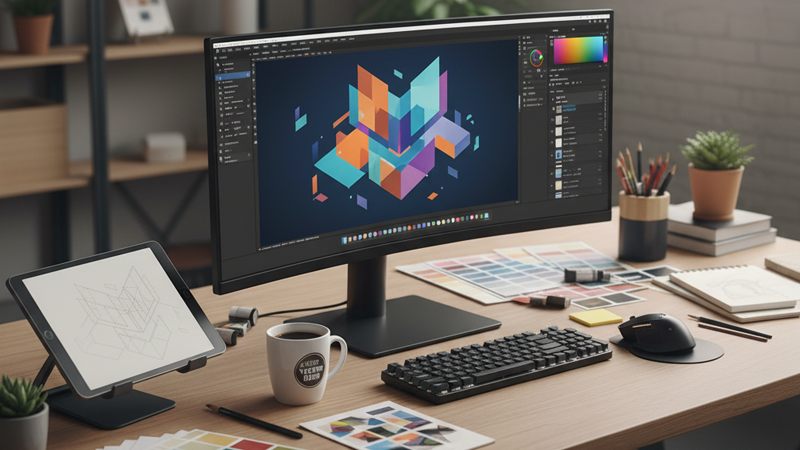What is Graphic Designing? Basics & Principles
Graphic design (often mistakenly searched as “graphics designing”) is a visual problem-solving process. It involves blending artistic creativity with technical skills to craft compelling visuals for various media, including print, digital screens, and physical spaces.
Core Principles of Design
Effective graphic design adheres to several fundamental principles that ensure the visual message is clear, engaging, and structured. Key principles include:
- Alignment: Creating order and visual connection by ensuring elements are lined up with each other.
- Balance: Distributing the visual weight of elements (color, size, texture) to achieve stability. This can be symmetrical (even) or asymmetrical (uneven but balanced).
- Contrast: Using opposing elements (e.g., light vs. dark, thick vs. thin, large vs. small) to create emphasis and guide the viewer’s eye.
- Hierarchy: Organizing design elements to show their order of importance, often achieved through size, color, or placement.
- Repetition: Reusing similar elements (fonts, colors, shapes) throughout a design to create consistency and reinforce the overall look.
- Proximity: Grouping related items together to create a relationship between them and declutter the overall design.
- White Space (Negative Space): The empty area around and between elements. It’s crucial for emphasis, readability, and bringing harmony to a design.
Graphic Designing Courses & Learning Paths
You can start learning graphic design after 10th or 12th grade through various educational paths, ranging from formal degrees to flexible online tutorials.
Educational Options
| Path | Duration | Focus/Format | Best For |
| Certificate Courses | 6–12 Months | Fundamentals, color theory, digital illustration, and specific software (e.g., Photoshop). | Quick entry, learning specific skills, or beginners after 10th. |
| Diploma Programs | 1–2 Years | Advanced principles, branding, layout, UI/UX basics, and portfolio development. | Gaining a strong foundation and preparing for entry-level jobs after 10th or 12th. |
| Bachelor’s Degree | 3–4 Years | Comprehensive, advanced graphic design, animation, visual branding, and theory. | In-depth knowledge, higher-level roles (e.g., Creative Director), and university life. |
| Online Courses (Udemy, Coursera, Skillshare) | Flexible | Specializations (Logo Design, Web Design, Motion Graphics) and software mastery. | Flexible self-learning, budget-conscious learners, and continuous skill updates. |
How to Learn
- Formal Training: Enroll in a university degree (like a BA in Graphic Design) or vocational training at a design institute.
- Self-Paced Learning: Use platforms like Udemy, Coursera (often partnered with universities like CalArts), and Skillshare for guided tutorials and project-based learning.
- Portfolio Focus: Regardless of the path, constantly work on personal projects to build a strong portfolio, which is the most critical asset for a designer.
Graphic Designing Tools & Software
Mastering industry-standard software is essential. The tools you use depend on your specialization.
Essential Software
| Tool | Primary Use | Specialization |
| Adobe Illustrator | Vector Graphics, Logos, Illustrations, Typography | Branding, Illustration, Iconography |
| Adobe Photoshop | Image Editing, Photo Manipulation, Raster Graphics | Photography, Digital Art, Image Retouching |
| Adobe InDesign | Page Layout, Multi-Page Documents | Publishing (Magazines, Books, Brochures) |
| Figma | User Interface (UI) Design, Prototyping | UI/UX Design, Web & App Design (known for collaboration) |
| Canva | Quick Social Media Graphics, Presentations, Simple Visuals | Beginners, Non-designers, High-volume content creation |
Free & Low-Cost Alternatives
- GIMP: Free, open-source alternative to Photoshop.
- Inkscape: Free vector graphics editor, similar to Illustrator.
- Affinity Designer/Photo: Powerful, low-cost alternatives to Adobe products with a one-time purchase model.
Hardware Requirements
- Computer/Laptop: Need sufficient RAM (16GB recommended) and a powerful processor to handle large design files and running multiple software.
- Graphics Tablet (e.g., Wacom, Huion): Useful for illustrating, sketching, and intricate photo-retouching, mimicking the feel of drawing by hand.
Career Scope & Salary in Graphic Designing
Graphic design has a bright scope, especially in the digital era, as every business needs visuals for branding, marketing, and web presence.
Career Opportunities
Graphic designers are employed across various industries or work independently:
- Visual Identity Graphic Designer: Focuses on logos, color palettes, and brand guidelines.
- Marketing & Advertising Designer: Creates social media graphics, web banners, and print ads.
- User Interface (UI) Designer: Designs the visual layout of websites and apps.
- Motion Graphics Designer: Creates animated graphics and videos.
- Packaging Designer: Designs product packaging.
- Publication Designer: Works on magazines, books, and reports.
Salary in Pakistan 🇵🇰
Salaries in Pakistan vary significantly based on experience, skill set, and location (Karachi, Lahore, and Islamabad generally offer better opportunities).
| Experience Level | Monthly Salary Range (PKR) – Full-Time (Approx.) |
| Entry-Level (1-2 years) | PKR 25,000 – 40,000 |
| Mid-Level (3-5 years) | PKR 50,000 – 80,000 |
| Senior-Level (7+ years) | PKR 100,000+ |
Remote & Freelancing Scope
Freelancing offers a much higher earning potential, especially for those working with international clients.
- Freelance Earnings: Skilled freelancers on platforms like Upwork and Fiverr can earn between PKR 50,000 to PKR 150,000+ per month or even charge $20–$100+ per hour for high-value projects, making this a lucrative path for work-from-home employment.
Graphic Designing Portfolio & Projects
Your portfolio is your resume. It’s a curated collection of your best work that demonstrates your skills, style, and problem-solving ability.
Key Portfolio Elements
- Diversity: Include projects across different types (logo design, web layout, social media ads, packaging).
- Case Studies: Don’t just show the final image; explain the client problem, your design process, and the solution.
- High Quality: Only showcase your absolute best work. Quality is better than quantity.
Creating a Portfolio
- Personal Website: Build your own portfolio website (using platforms like Behance, Dribbble, or custom sites) for a professional look and easy sharing.
- Design Projects: If you lack real client work, create mock projects (e.g., rebranding a well-known local company, designing an app concept, or a conceptual poster series).
- Templates: While templates exist, a personalized, well-structured layout that reflects your aesthetic is generally more impactful.
Future of Graphic Designing & Trends
The future of graphic design is heavily influenced by technology, digital experiences, and a shift towards more immersive content.
Future Trends (2025 Onwards)
- AI in Design: AI tools are becoming design assistants, helping with ideation, generating initial concepts, and speeding up workflow (e.g., one-click background removal). The designer’s role shifts to “Art Director” for AI.
- UI/UX Focus: Demand for designers specializing in User Interface (UI) and User Experience (UX) for apps and websites will continue to grow exponentially.
- Motion Graphics & Animation: Static graphics are being replaced by animated content (Storytelling Animation, 3D characters) across social media and digital platforms.
- New Aesthetics: Expect to see trends like Conceptual & Abstract Design, Bold Minimalism (simple design with heavy emphasis), and a return to Retro Vibes (with a modern twist).
- Digital Marketing: Graphic designers remain indispensable in creating conversion-focused visuals for all digital marketing channels.
FAQs about Graphic Designing
What qualification is needed to become a graphic designer?
No specific academic degree is strictly mandatory; a strong portfolio and mastery of skills are most important. A high school diploma (or 10th/12th pass) is often the minimum to enroll in formal courses, but many successful designers are self-taught.
What are the essential skills required?
Hard Skills: Mastery of Adobe Creative Suite, Typography, Color Theory, Layout/Composition, and basic understanding of UI/UX. Soft Skills: Creativity, problem-solving, attention to detail, communication, and the ability to take feedback.
What is the typical career path?
- Beginner: Certificate/Diploma/Self-Learning.
- Entry-Level: Intern or Junior Graphic Designer.
- Mid-Level: Graphic Designer or Specialist (e.g., Logo Designer, UI Designer).
- Senior-Level: Senior Designer, Art Director, or Creative Director.
Conclusion / Wrap-Up
Graphic designing is a dynamic and rewarding career that combines creativity with strategic communication. With flexible learning paths available—from formal degrees to powerful online courses—and significant opportunities in local and international freelance markets, now is a fantastic time to start your creative journey in design! Focus on building your skills, mastering the core principles, and creating a standout portfolio to unlock a fulfilling and high-demand career.


